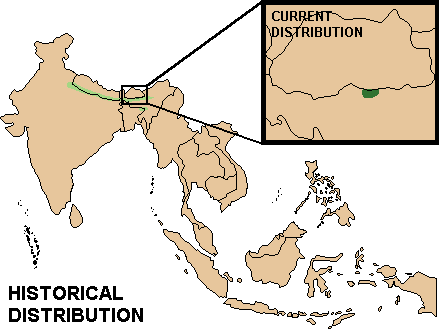Kingdom: |
Animalia |
Common name:
Scientific name:
Other names: |
Pygmy hog
Porcula salvania
Sanglier Nain, Sanglier Pygmée, Jabalí Enano, Jabalí Pigmeo, Nul gowri, Chota-suar |
Physical Characteristics
- Head and body length:
55-71 cm
- Shoulder height: 20-31 cm
- Tail length: 3 cm
- Adult weight: 6.6-9.7 kg
- Shoulder height: 20-31 cm
Males tend to be larger than females. Both sexes are dark grayish brown overall, with rather sparse hair and no distinctive markings. The body is short-legged and streamlined, well-adapted to moving through tall, dense grasses. The tail is extremely short. Males have sharp tusks which protude inconspicuously from the mouth. There are no facial "warts" present, but adult males typically develop a "moustache" of long, pale hairs above their upper lip.
- Similar species
- The pygmy hog is extremely distinct on account of its small size; sympatric wild pigs (Sus scrofa) are significantly larger and unlikely to be confused with this species.
Reproduction and Development
- Gestation period:
110-120 days.
- Litter size: 2-6, usually 3 or 4.
- Weaning: Unreported.
- Sexual maturity: Poorly known; perhaps as early as 11-13 months.
- Life span: Up to 14 years in captivity; perhaps half this in the wild.
- Litter size: 2-6, usually 3 or 4.
Reproduction is very seasonal; breeding typically occurs very early in the year (January or February), and the vast majority of births occur in late April and May, at the beginning of the monsoon. Females build a nest out of thatch in which to give birth, and the infants remain hidden within for about one week. Infants develop vague reddish stripes approximately one month after birth.
Ecology and Behavior
- Family group:
Small maternal groups of one or more adult females and their young, usually totalling 4-6 animals. Adult males are often solitary, and may loosely associate with females.
- Diet: Omnivorous: roots, leaves, grasses, fruits, and seeds, as well as invertebrates and possibly eggs and carrion.
- Main Predators: Pythons, raptors, and potentially large carnivores. Infants may be depredated by mongooses, small cats, and crows
- Diet: Omnivorous: roots, leaves, grasses, fruits, and seeds, as well as invertebrates and possibly eggs and carrion.
Habitat and Distribution

Conservation Status
- IUCN Red List:
Critically Endangered (2008)
- CITES Listing: Appendix I (2011)
- Threats: Habitat loss and degradation, and illegal hunting.
- CITES Listing: Appendix I (2011)
The total population is estimated at fewer than 250 mature individuals, most of which live in a single subpopulation within Manas National Park. In 1996, the Assam-based Pygmy Hog Conservation Programme began conservation breeding with six founder animals; it has since expanded to two captive breeding facilities housing over 60 animals, with reintroductions to the wild begininning in 2008. To date (2013), 74 captive-born hogs have been released in Sonai Rupai Wildlife Sanctuary and Orang National Park, and signs of successful breeding have been observed.






